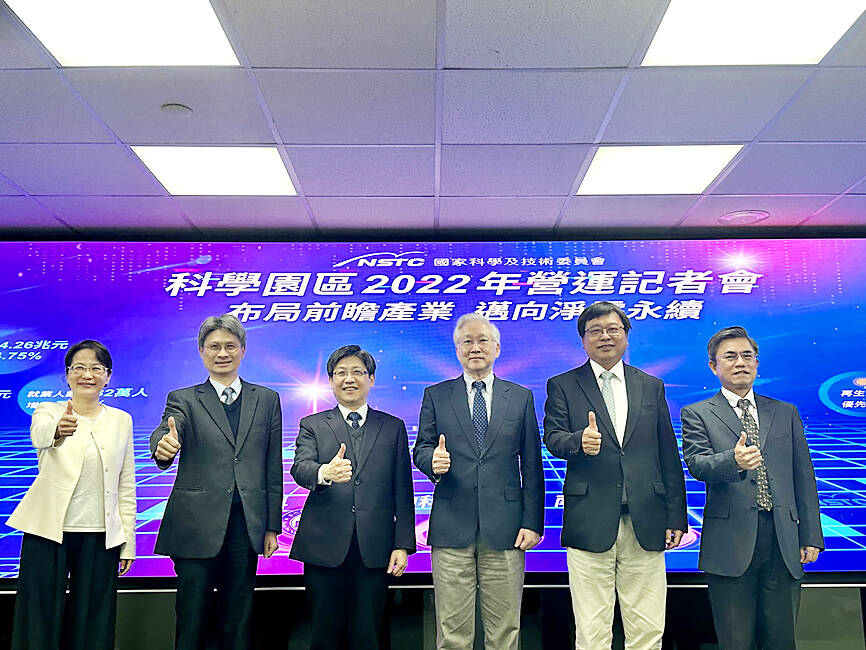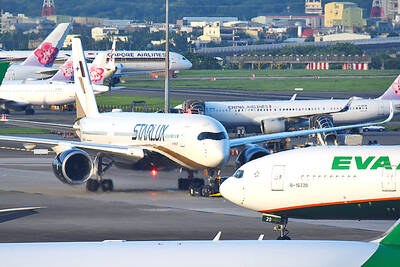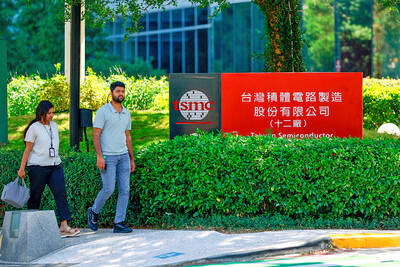The nation’s three major science parks posted record combined revenue of NT$4.27 trillion (US$139.3 billion) for last year, up 14.75 percent year-on-year, the National Science and Technology Council said in a report yesterday.
The council attributed the robust performance to a recovery in consumption after experiencing three years of COVID-19 curbs, as well as steady sales increases driven by semiconductor demand for emerging applications such as artificial intelligence of things, 5G and high-performance computing.
The Hsinchu Science Park (新竹科學園區) saw revenue rise 1.59 percent annually to NT$1.61 trillion, and the Central Taiwan Science Park (中部科學園區) posted revenue growth of 13 percent to NT$1.17 trillion, while that of the Southern Taiwan Science Park (南部科學園區) grew 35.48 percent to NT$1.48 trillion, the report said.

Photo: CN
Higher revenue growth at the Southern Taiwan Science Park came as Taiwan Semiconductor Manufacturing Co (台積電) began producing chips using the 5-nanometer process there, the council said.
The three parks exported a combined NT$2.79 trillion of goods last year, up 2.72 percent from a year earlier, while their combined imports surged 81.81 percent to NT$2.02 trillion, it said.
The high growth in imports was a result of companies continuing to build factories and expand production, while increasing purchases of precision machinery and equipment from abroad, the report said.
Overall, the three parks saw two-way trade rise 25.72 percent year-on-year to NT$4.81 trillion last year, also a new high, the report said.
The three parks last year also employed a record 323,113 people, up 7.09 percent from 2021, it said.
“Despite global turmoil triggered by the war in Ukraine, China’s [COVID-19] lockdowns and high inflation, the science parks continue to play a stabilizing role as semiconductor clusters, with companies from upstream to downstream performing strongly last year,” the council said in the report.
“In addition to contributing to the nation’s GDP growth, the science parks helped bolster Taiwan’s indispensable role in the global high-tech industry,” it added.
Of the parks’ six major industries, the integrated circuit industry placed first in terms of revenue, rising 22.62 percent year-on-year to NT$3.33 trillion, followed by the computer and peripherals industry with an increase of 30.2 percent to NT$213.01 billion, the report said.
Communications industry revenue increased 25.21 percent, precision machinery sales rose 10.45 percent and biotechnology sales edged up 0.84 percent, it said.
However, optoelectronics industry revenue fell 24.89 percent annually due to a relatively higher comparison base the previous year, as well as falling flat-panel prices and inventory adjustments amid cooling demand in the end market, the report said.
The council said it is anticipating a flat or mild increase in the parks’ revenue this year, despite growing headwinds created by persistent inflation, the war in Ukraine, a slowing global economy and escalating US-China tensions.

RECYCLE: Taiwan would aid manufacturers in refining rare earths from discarded appliances, which would fit the nation’s circular economy goals, minister Kung said Taiwan would work with the US and Japan on a proposed cooperation initiative in response to Beijing’s newly announced rare earth export curbs, Minister of Economic Affairs Kung Ming-hsin (龔明鑫) said yesterday. China last week announced new restrictions requiring companies to obtain export licenses if their products contain more than 0.1 percent of Chinese-origin rare earths by value. US Secretary of the Treasury Scott Bessent on Wednesday responded by saying that Beijing was “unreliable” in its rare earths exports, adding that the US would “neither be commanded, nor controlled” by China, several media outlets reported. Japanese Minister of Finance Katsunobu Kato yesterday also

Taiwan’s rapidly aging population is fueling a sharp increase in homes occupied solely by elderly people, a trend that is reshaping the nation’s housing market and social fabric, real-estate brokers said yesterday. About 850,000 residences were occupied by elderly people in the first quarter, including 655,000 that housed only one resident, the Ministry of the Interior said. The figures have nearly doubled from a decade earlier, Great Home Realty Co (大家房屋) said, as people aged 65 and older now make up 20.8 percent of the population. “The so-called silver tsunami represents more than just a demographic shift — it could fundamentally redefine the

China Airlines Ltd (CAL, 中華航空) said it expects peak season effects in the fourth quarter to continue to boost demand for passenger flights and cargo services, after reporting its second-highest-ever September sales on Monday. The carrier said it posted NT$15.88 billion (US$517 million) in consolidated sales last month, trailing only September last year’s NT$16.01 billion. Last month, CAL generated NT$8.77 billion from its passenger flights and NT$5.37 billion from cargo services, it said. In the first nine months of this year, the carrier posted NT$154.93 billion in cumulative sales, up 2.62 percent from a year earlier, marking the second-highest level for the January-September

‘DRAMATIC AND POSITIVE’: AI growth would be better than it previously forecast and would stay robust even if the Chinese market became inaccessible for customers, it said Taiwan Semiconductor Manufacturing Co (TSMC, 台積電) yesterday raised its full-year revenue growth outlook after posting record profit for last quarter, despite growing market concern about an artificial intelligence (AI) bubble. The company said it expects revenue to expand about 35 percent year-on-year, driven mainly by faster-than-expected demand for leading-edge chips for AI applications. The world’s biggest contract chipmaker in July projected that revenue this year would expand about 30 percent in US dollar terms. The company also slightly hiked its capital expenditure for this year to US$40 billion to US$42 billion, compared with US$38 billion to US$42 billion it set previously. “AI demand actually